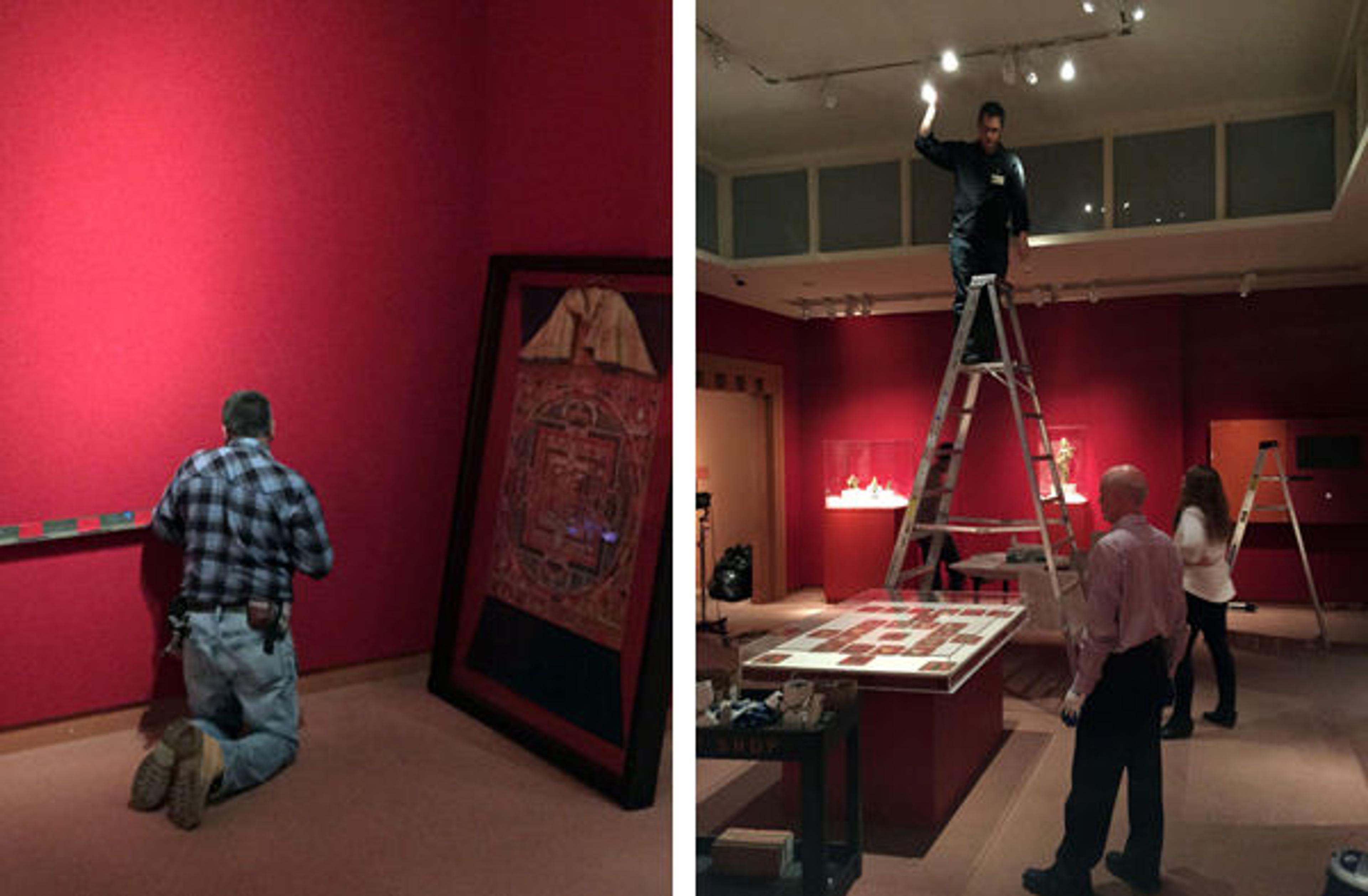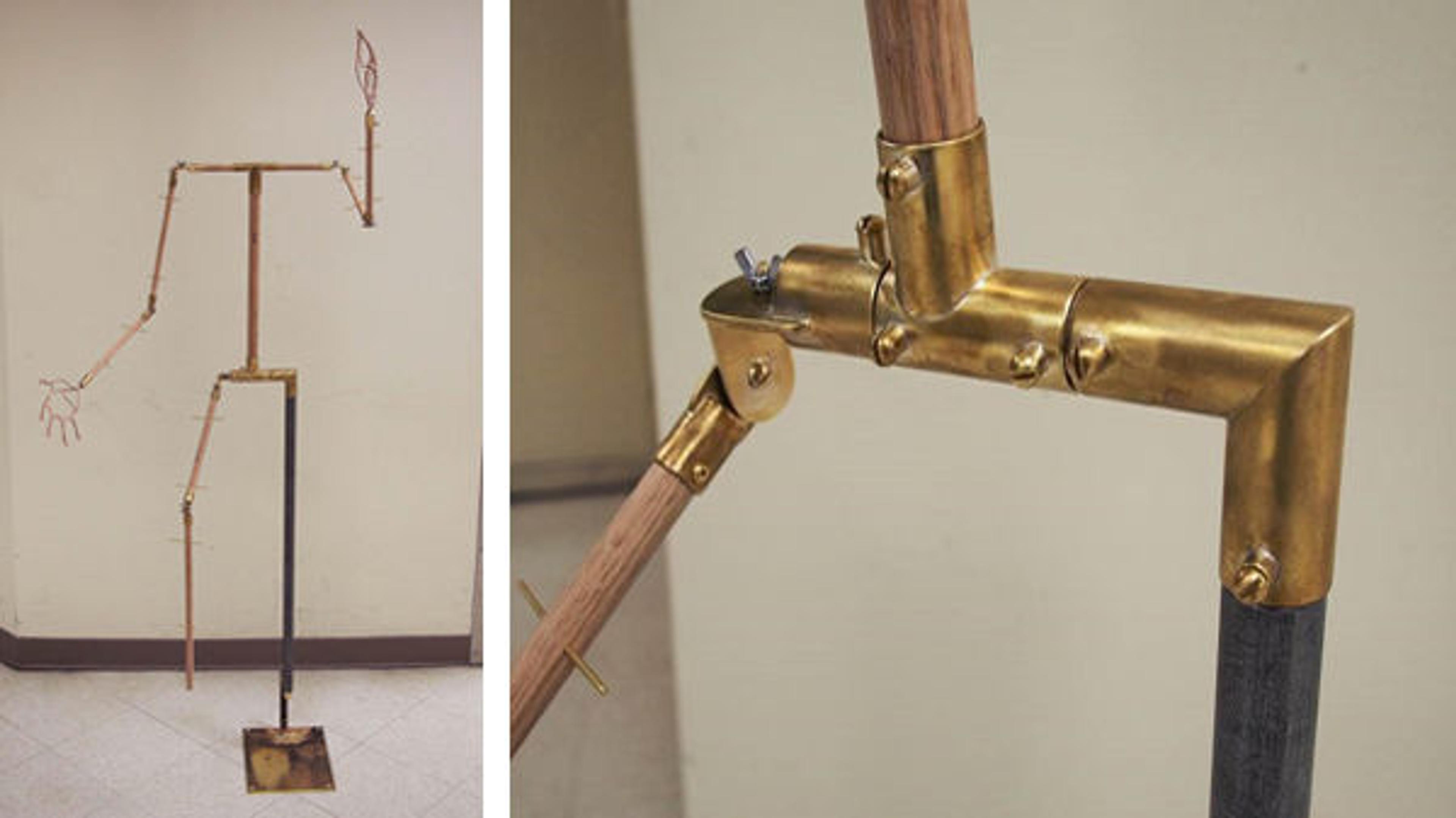
Pair of woman's earrings, 19th–early 20th century. Tibet, Lhasa area. Gold and turquoise; 3 1/2 x 1 1/2 in. (8.9 x 3.8 cm). The Metropolitan Museum of Art, New York, John Stewart Kennedy Fund, 1915 (15.95.91, .92)
Kurt Behrendt
During the earliest stages of conceptualizing the Sacred Traditions of the Himalayas exhibition, on view through June 14, I went through the Metropolitan Museum's holdings and came across a stunning body of jewelry that came to the collection in 1915. As the Department of Asian Art is celebrating its centennial this year, I was excited to have the opportunity to present the very first Himalayan works to come into our collection—the first of many works acquired beginning exactly one hundred years ago.
Emblematic of this collection of Himalayan art are these earrings from the Lhasa area of Tibet shown above, with their finely shaped, pure-blue turquoise elements associated with health and life. The Met's initial foray into the arts of the greater Himalayan region provided a strong foundation, and today the Museum is in the position of presenting the art of this region at the highest level.

Exhibition floor plan for gallery 251. Image courtesy of Daniel Kershaw
Designing the display for Sacred Traditions was unique in that a plan needed to be developed to highlight both jewelry and an elaborate skeleton dance costume, while at the same time finding a balance in presenting the many other artworks integral to the show. After working closely with Exhibition Design Manager Daniel Kershaw, a floor plan was created that provided the visitor with a meaningful juxtaposition of artworks in a space that lent itself to reflection. Even though this was a smaller exhibition, a tremendous amount of preparation was still required for the display.

Left: View showing the installation of a support for the adjacent Manjushri mandala (the Bodhisattva of Transcendent Wisdom). Right: Lighting the Tsakali initiation card mandala in the center of the gallery. Photos courtesy of Kurt Behrendt
After the installation was complete, the Lighting Design team came in to ensure that each work was presented effectively. Given that many of the objects in this exhibition are sensitive to light, this proved to be a critical aspect of the exhibition design. Setting light levels and then adjusting the overall presentation to create an aesthetically balanced presentation is an art unto itself.
Some of the final items to go into an exhibition are the labels and text panels, which need to communicate key information to visitors while remaining succinct. The Digital Media Department was then able to enhance the exhibition by integrating an in-gallery digital presentation, promoting the exhibition on the website, Met Blogs, and across its social media channels, with the exhibition hashtag providing a means to present more detailed and in-depth discussions of the exhibition online.
Throughout the exhibition's blog series, my colleagues in Paper Conservation and Objects Conservation have written about their processes in preparing the objects for display in Sacred Traditions. Another of the exciting objects on view in the exhibition requires a similar behind-the-scenes look at its preparation for this show: a Tibetan skeleton dance costume that was given to the Museum in 1932. This dramatic costume speaks to the transience of existence, and would have been used in public and monastic ceremonies. Its display posed immediate challenges, but fortunately Kristine Kamiya from the Department of Textile Conservation was able to address the costume in terms of materials and work that needed to be done in order to stabilize it for display.
Kristine Kamiya

Skeleton dance costume, late 19th or early 20th century. Tibet. Silk, flannel; 70 x 60 in. (177.8 x 152.4 cm). The Metropolitan Museum of Art, New York, Gift of Mrs. Edward A. Nis, 1934 (34.80.3a–h)
The skeleton dance costume is composed of eight sections: a jacket, trousers, two boots, two gloves with claws, an animal apron, and a fringed belt. The costume is constructed from a variety of materials as well as fabric types, which include a red woven felt, white silk damask, red coarse plain-weave cotton, red plain-weave silk, patterned silk brocade with supplementary gold metal threads, velvet (cut and uncut, voided, leopard- and tiger-patterned), silk fringe tassels, leather, horn (for the claws), and metal bells.

Fortunately the costume was in fairly good condition overall, with the majority of damage located on the thin and fragile silk lining the fabrics of the jacket, trousers, and boots. In order to display the costume on a mannequin, it was necessary to conserve the damaged lining. A first look with the microscope to identify and check the condition of the fibers and access their fragility showed that they were indeed fragile, but in stable-enough condition for conservation with stitches. In order to reduce the wrinkles and creases, as well as to align the warps and wefts, humidification was applied to back and support the damaged areas with new silk fabric insertions, so as not to cause further distortion or damage.
Consolidation of the damaged areas were completed with laid-in couching stitches. As a protective measure for display on a mannequin, the costume components were lined with new silk fabrics to serve as a barrier and to prevent further abrasion and damage while dressing the costume on the mannequin.

Jacket lining prior to treatment (top); new jacket lining during treatment (bottom). Photos courtesy of Kristine Kamiya

Jacket sleeve prior to treatment (top); jacket sleeve during treatment, showing the placement of a new fabric insertion (bottom). Photos courtesy of Kristine Kamiya
The next step was to work with Conservation Preparator Matthew Cumbie from the Department of Objects Conservation to design a mannequin with removable parts that would not stress the construction and materials of the costume during its installation and desintallation.
Matthew Cumbie

Brass is heated to create an adjustable mannequin frame. Photo courtesy of Matthew Cumbie
In order to display the skeleton costume, I set out to build a custom mount for the figure. Working specifically with brass and wood, I first built a ridged, adjustable frame.

Two views of the brass and wood mannequin mount. Photos courtesy of Matthew Cumbie
As the figure needed to be presented in an animated, dramatic posture suited to its use in dance, the frame needed to be articulated like a human body. Moreover, many of the elements needed to be detachable so that the mount could be dressed in such a way that it did not cause stress on the costume.

The mannequin's hands during construction (left) and covered in ethafoam (right). Photos courtesy of Matthew Cumbie
The hands were particularly challenging, and were built over a wire armature so that the fingers could assume a realistic form. Next they were encased in ethafoam to give them shape, and this same principle was applied to the wood framework with articulated brass joints to give the figure a realistic volume. This extremely lightweight, articulated mount allowed for the skeleton costume to be presented in an animated way that suggested its original function.

Left: Matthew sculpts the ethafoam so that it approximates the shape of the dancer's body. Right: The costume is installed on the mannequin mount prior to display. Photos courtesy of Matthew Cumbie
Kurt Behrendt
Although the exhibitions at The Metropolitan Museum of Art appear as anonymous creations, such displays are, in fact, the collaborative creations of many people across the Museum. In the case of Sacred Traditions of the Himalayas, more than seventy people contributed to this effort—including colleagues from the Exhibition Office, Design, Objects Conservation, Paper Conservation, Textile Conservation, Asian Art Conservation, Editorial, Digital Media, Photo Studio, Education, the Carpenters Shop, the Plexi Shop, the Riggers, and, of course, the staff of the Department of Asian Art. I want to thank all of these collaborators; certainly the quality of the exhibition is a testament to their skill and creative talents.
View all blog articles related to Sacred Traditions of the Himalayas.
Read an essay by Katherine Anne Paul, PhD, curator of the Arts of Asia at the Newark Museum, on the Newark Museum's collection of photographs of Tibet.